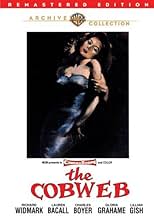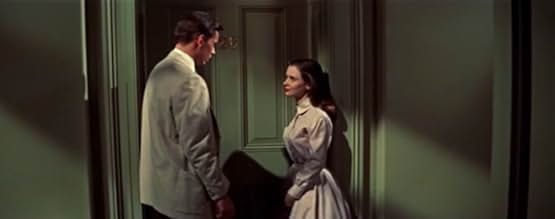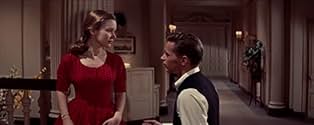Dans une clinique psychiatrique, les drames quotidiens et les interactions entre les médecins, les infirmiers, les administrateurs, les bienfaiteurs et les patients sont accentués par les cr... Tout lireDans une clinique psychiatrique, les drames quotidiens et les interactions entre les médecins, les infirmiers, les administrateurs, les bienfaiteurs et les patients sont accentués par les crises personnelles et familiales de ces individus.Dans une clinique psychiatrique, les drames quotidiens et les interactions entre les médecins, les infirmiers, les administrateurs, les bienfaiteurs et les patients sont accentués par les crises personnelles et familiales de ces individus.
- Réalisation
- Scénario
- Casting principal
Avis à la une
The main difference between patients and staff is that the patients seem more self aware, often knowing just what their problems are, in contrast to the staff who flounder in self ignorance while totally unaware of their own internal issues. Overall the film lacks much depth, maybe the depth was lost in the editing process, so that we are left with...well...mostly just drapes (at least four different sets of drapes by my count, if you include the originals that are to be replaced). Maybe the writers of this story had a drapery fetish? Strange, but you never know!
Lillian Gish and Gloria Grahame steal the movie and their performances are worth your viewing time. The whole movie is a guilty pleasure, as neither inmates nor staff seem to be in charge of this asylum. Its fun to watch as the wheels come off and the "Institute for Neurosis" descends into 1950's campy chaos.
How it ever got the green light from the studio is mystery number one, that Vincente Minnelli said okay to directing it is the second although that would explain why so many great actors allowed themselves to be involved.
Everybody gives overheated performances except Lauren Bacall who keeps a low-key dignity amongst the melodrama and Susan Strasberg offers a restrained quiet portrait of a shut-in who is making her first tentative steps towards reemerging into the world.
The rest of the players aim for the rafters to varying degrees from Richard Widmark's impassioned but distracted doctor who is merely agitated then there is Lillian Gish who chews a bit of scenery as a bitter spinster as well as many other respected actors who show little restraint.
The real standout though is Gloria Grahame as Richard's hot mess of a wife, she seems to realize how silly the whole thing is and pitches her performance to that tempo, she's jittery, flouncy and fun plus she looks great.
Laughable take on mental health but good for one fun viewing as a camp catastrophe.
It's an absorbing story of the patients and the doctors at a mental institution. Widmark has basically taken over from the troubled Boyer - though Boyer retains his title, Widmark's contract gives him more power. Bacall, a recent widow, is a doctor on staff, and Lillian Gish is an administrator. The patient most focused on is Stevie, played by John Kerr. He is making good progress with his recovery, and in fact, some of the better patients are given control over designing their lounge. The sticking point becomes the draperies which become a political football. Widmark's wife, Gloria Grahame, wants to impose herself onto the institution that is taking her husband away from her by working with a board member on the drapes; Lillian Gish wants to save money and go the cheap route; and the patients have their own ideas.
This is a very good drama with good acting from all involved. Grahame is a brunette here and has never been more beautiful, plus she gets to wear some beautiful clothes. She, along with the others, gives a terrific performance.
The one with the best role is Lillian Gish, and she is fantastic. What an actress and what a career. Who could have believed she could play such a perfect bitch? Well worth watching if the plot is a little thin.
What's interesting is that there is no antagonist; like "Howards End" or Eastwood's "Unforgiven", all the characters do bad things for understandable reasons and thus construct the cobweb. This compares favorably with other nuthouse movies, especially ones about the group therapy system--"Cuckoo's Nest" (based on Ken Kesey's novel of 1950, 5 years before "Cobweb") and "The Caretakers" with Joan Crawford as the inflexible head nurse. Those films tend to focus on patients having hysterics and running riot. They don't indict the system but one despotic individual within it (a head nurse); Kesey's narrator claims that she represents a larger controlling force but even then shows that other wards in the hospital are not the same. However, "Cobweb" takes a more subtle nobody's-fault approach that ultimately has wider, darker implications. It implies that these pitfalls are endemic to the system because they are part of human nature, which is a more sinister idea (especially for the 50s) than being able to blame a convenient mini-Hitler. Therefore, it works more convincingly as a microcosm of a society that thinks it's healthy. It's also more salutary and hopeful than those films because it proceeds from this clear-eyed cautionary assessment.
In the true sense of "melodrama," it underlines apparently innocuous early scenes with heavy foreboding music by Leonard Rosenman. It's also astonishing to watch Lillian Gish play a b----. And she does a great job.
Minnelli uses a bit of the soundtrack of Seven Brides For Seven Brothers, here (the picture that trumped his own Brigadoon at the box office) - in a scene at the movies. Guess he had no hard feelings.
One of Minnelli's interesting misfires. Even though it doesn't really work, I've seen it three or four times.
The acting is good, overall. Richard Widmark (as the director of the clinic) has two leading ladies, Lauren Bacall and Gloria Grahame. This is one of the few times I've ever really seen Grahame miscast. She had a wide range, after all she played everything from Violet Bick in It's A Wonderful Life, to Rosemary Bartlow in The Bad And The Beautiful, to Ado Annie in Oklahoma. But I think you will agree her role defeats her best efforts here. She starts out very well but I'm not sure I always understood where she was coming from as the film wore on. Bacall plays a simple, sensible girl, and does a good job. Lillian Gish plays the unpredictable Miss Inch, Charles Boyer the self-destructing Dr. Devanal, John Kerr the young and artistic Stevie (a role originally announced for James Dean). Oscar Levant is called upon to go outside his usual comfort zone and I'm not sure he makes it. Susan Strasburg is excellent in a small role.
Le saviez-vous
- AnecdotesMarks the return of Lillian Gish to MGM after a 22-year absence. The Cobweb was Lauren Bacall first film for MGM.
- GaffesWhen Karen (Gloria Grahame) storms into her bedroom and kicks off her shoes, she apparently launches the first one over the walls of the set, as it shoots straight up toward the supposedly low ceiling but never comes down.
- Citations
Steven Holte: Artists are better off dead.
Karen McIver: Why?
Steven Holte: People pay more attention to them when they're dead. That's what's so troublesome.
Karen McIver: Is that what you are, a painter?
Steven Holte: They said Van Gogh was crazy because he killed himself. He couldn't sell a painting while he was alive, and now they're worth thirty million dollars. They weren't that bad then and they're not that good now, so who's crazy?
- ConnexionsFeatured in Le point de non-retour (1967)
Meilleurs choix
- How long is The Cobweb?Alimenté par Alexa
Détails
- Date de sortie
- Pays d’origine
- Langue
- Aussi connu sous le nom de
- La Toile de l'araignée
- Lieux de tournage
- St. Louis Street, Lot 3, Metro-Goldwyn-Mayer Studios - 10202 W. Washington Blvd., Culver City, Californie, États-Unis(McIver's neighborhood, demolished in 1972)
- Société de production
- Voir plus de crédits d'entreprise sur IMDbPro
Box-office
- Budget
- 1 976 000 $US (estimé)
- Durée
- 2h 14min(134 min)
- Rapport de forme
- 2.55 : 1

























